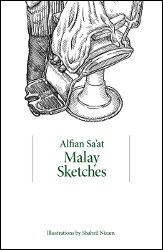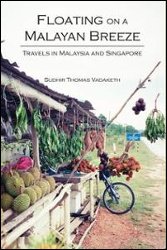|
by Goh Cheng Fai Zach
 
Alfian Sa'at, Malay Sketches, Ethos Books, 2012. 232 pages.
Sudhir Thomas Vadaketh, Floating on a Malayan Breeze: Travels in Malaysia and Singapore, Hong Kong University Press and NUS Press, 2012. 282 pages. Alfian Sa'at's Malay Sketches takes its name from a book of anecdotes written in 1895 by Frank Swettenham, the first Resident-General of the Federated Malay States, and which is quoted in the epigraph. In the original, Swettenham writes that his book is where "The tale of these little lives is told. If I have failed to bring you close to the Malay, so that you could see into his heart, understand something of his life, then the fault is mine." Whereas Swettenham looked at the Malay as an outside observer, Alfian Sa'at writes from the perspective of a "fellow man." In new collection of short stories, Alfian aims at showing the reader what it means to be Malay and "the realities of life as an ethnic minority" living in Singapore. Of course, the book's themes also run deeper and underlying all its anecdotal short stories is the question of what it means to be human. Although Malay Sketches can be seen as a peephole into the Malay psyche, the stories will be relatable to readers, no matter their country or ethnicity. Stories of love, sadness, betrayal and success and failure make this collection accessible and, most importantly, human. Sudhir Thomas Vadaketh's Floating on a Malayan Breeze similarly discusses issues of Singaporean and Malayan identity. The book is a critical commentary of the political, economic and social state of Malaysia and Singapore cleverly disguised as a piece of "travel writing." In 2004, Vadaketh and his friend Sumana Rajarethnam, two Singaporeans, decided to spend a month cycling around Malaysia on a daily budget of RM10. Together they "visited hundreds of towns, met many fascinating people, had countless conversations, and landed in several comedic capers." It must be noted that the book's focus, however, is not really on travelling, and you will not find any reviews of hotels, restaurants or tourist destinations in its pages. Instead, it looks into the lives of Malaysians and explores how they can reflect how Singaporeans lead their own lives. The book also deals with the differences between Malaysia and Singapore—in terms of language, politics, sociology, religion and even attitudes towards life and happiness—and looks at various issues of shared national interest, including history, imagined identities and separation anxieties, politics and government, the role of the media, the judiciary and civil society, business and economic development, ethnicity and race and the influence of religion. Vadaketh does not allow these wider themes to detract from telling a good story, and the travel sections of Floating make for an engaging read. The explorers meet up with various interesting characters, such as an ex-communist living in Betong, Thailand, selling trinkets to tourists and a former actor-turned-bomoh, or shaman, who tries to "heal" Sumana's knee. Vadaketh is careful, however, to lace these tales with anecdotes that help frame his argument. He also pulls out to look at many events that are of national interest to both Malaysia and Singapore, including the Separation of Singapore from Malaysia in 1965, the May 13 1969 riots, the Bumiputera policy, the 2008 elections in Malaysia and more recent disputes between the two countries over land, water and airspace. Together, both Sketches and Floating explore the larger issue of identity and what it means to be a Malayan. Vadaketh uses "Malaya" to refer to both Malaysia and Singapore, because he grew up thinking of the two countries as one, and Alifan discusses the relationship between Singaporean and Malayan identifies in several stories. For example, in "The Convert," Jason, a Chinese Singaporean who has converted to Islam for marriage, is demoted from Combat Engineer to Infantry Specialist, with hints that it is because of his newly adopted Malay-Muslim identity. This is echoed in Floating, where Vadaketh discusses the notion of Malays not being allowed to hold certain "high security" positions in the Singapore Armed Forces as they cannot be trusted with military secrets. This idea is expanded to justify the need for the Bumiputera policy in Malaysia, a form of affirmative action designed to give Malays an advantage over Chinese in business, so that they can compete in economic matters. However, "Shallow Focus," another story from Sketches, challenges the notion that Malays are unable to compete with the Chinese without assistance. In it, the unnamed Malay narrator, a recent engineering graduate, encounters his old academic rival, a Chinese boy named Min Heng, who is working as a freelance photographer and is taking the engineering student's graduation photographs. The narrator asks whether by being more successful than Min Heng, he has become more Chinese than him, while his mother asks if Min Heng has become more Malay because he is happy with what he is doing. Racial identity and stereotypes are thus confronted: what does it really mean to be Chinese or Malay? The vexed issue of the growing presence and influence of Mainland Chinese in Singapore is also highlighted in both books. In "Two Brothers," Helmi, the older of a pair of twins, frets about how a policy to keep the city state seventy-five per cent Chinese is resulting in a flood of mainland Chinese workers who are taking over the labour force and whose lack of English is threatening the country's multicultural way of life. In Floating, there is also a chapter dedicated to discussing the effects Mainland Chinese workers are having on the Singaporean society and labour force. Vadaketh claims that it is much easier to hire workers from China than elsewhere, and he sees the specific targeting of Chinese migrants as a deliberate attempt by the Singaporean government to keep the proportion of Chinese in the country high. He also questions whether or not this should be the case, if Singapore is to become a truly multicultural and cosmopolitan city, and worries that social integration has suffered as a result of the huge influx of Chinese migrants. Finally, he raises the issue of language, writing that "many are uncomfortable with the increased usage of Mandarin in the country." Amidst all the different issues that divide the two nations, however, Vadaketh suggests that in some sense Malaysia and Singapore are inseparable, though this is hardly the case politically. He writes that "since 1965, Malaysia and Singapore have tried hard to create distinct nation states. For each country, that has often meant defining itself against the other. Each has tried hard to show how it is different...and yet...both countries are still struggling to come to terms with their founding principles." He further contends that "as Malaysia and Singapore embark on their next stage of development, they will have to be more like each other," and that Malaysians will want greater "equality of opportunities, while Singaporeans will want greater "equality of outcomes," which is his main argument. At point, Vadaketh states that "Singapore does not have a hinterland within its borders," a statement which finds an echo in Alfian: "Malaysian minus hinterland minus history minus soul = Singaporean." But it is possibly the search for a soul for Singaporeans, the search for identity and history that makes his Malay Sketches resonate with both Malaysian and Singaporean audiences. For try as they might, these nations are still inseparable in terms of history and culture, even if they are divided politically. |